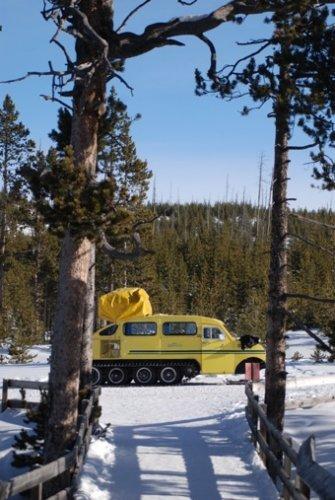With Yellowstone National Park managers back at work on producing a winter-use plan pertaining to getting around the park, at least one group has mounted a campaign to see some of the park's roads plowed in winter.
The folks behind Plow Yellowstone Park would like to see the road from West Yellowstone, Montana, to Old Faithful in the park's interior kept open during the winter months.
It seems the environmental groups are all focusing on what type of winter vehicle, and how many, should be allowed in the park in winter. They are focused on the wrong question. The question is, should it continue to be over snow travel at all? Why not plow the roads?
Plowing the roads would accomplish many things. The first and most important being public access for all, similar to the method presently employed from mid April to November 1st in Yellowstone. People would be allowed into Yellowstone in their own vehicles. (Any vehicle that can make it to West Yellowstone from either Idaho Falls, Idaho, or Bozeman, Montana, could make the trip from West to Old Faithful.) You could use your National Park Pass, or get a 7 day weekly pass for $25. The only other cost would be fueling the vehicle and whatever other amenities one plans to purchase in Yellowstone.
Plowing Yellowstone's roads is not a new idea. In his book, Yellowstone and the Snowmobile, Locking Horns Over National Park Use, writer Michael Yochim points out that in 1931 officials in Cody, Wyoming, on the park's eastern side began lobbying to see Yellowstone's roads kept open in winter. Mr. Yochim also pointed out that in 1998, when Yellowstone officials were working on an earlier winter-use proposal, they then considered plowing the road from West Yellowstone to Old Faithful.
One of the primary benefits of this idea was that it would substantially reduce costs for both the agency and the public. Visitors would be able to tour the park in their own vehicles rather than renting snowmobiles at over $100 per day (riding double on a snowmobile could halve the per person cost, but few chose to do so) or buying snowcoach tickets, which started at about $60. The plowing idea was not unique to the NPS; at a three-day conference in October 1998 with other local government agencies interested in Yellowstone's winter use, two different work groups (out of five, total) independently came up with the same idea. With several groups thinking the same way, park planners were confident enough to incorporate the limited plowing proposal into the preferred alternative in the Draft EIS.
But the plowing option never has seemed to gain much traction, surely not enough to go head-to-head with those who favor snowmobiles or those who favor snowcoaches for touring Yellowstone in winter. That's somewhat surprising, in light of the benefits it would provide, as Mr. Yochim pointed out:
With the reality of global warming and the human contribution thereto now proven and commonly accepted, it would be irresponsible for the NPS to convert to a snowcoach-only transportation system when more fuel-efficient options, such as public buses and vans (on wheels, not tracks and skis), are readily available. In addition to contributing less to global warming, buses and vans would affect park resources less than oversnow vehicles do; furthermore, because they have fewer moving parks and have been regulated for years, buses are quieter than oversnow vehicles. ... Using buses and vans would cause parkwide fuel use to decline because visitor travel would consume less fuel and the NPS would not need to plow roads in spring (the overall fuel and labor used to plow roads in winter would be similar to the amounts currently used to groom the, but the lack of spring plowing would save large amounts of fuel and reduce labor costs). ... In short, public transportation and associated plowing would better protect visitor pocketbooks, park resources, global climate, and Yellowstone's retreat-like nature than either snowcoaches or snowmobiles.
Yellowstone officials currently are collecting public comment on winter-use in the park through the end of March.




Comments
I think we all need to think of the big picture...access. The animals are there for people to see. Not just drive by on a highway like 191 and say, "You know, there's wild animals in the park in the winter too".
And yes, the park has been for the rich for some time, but it's also for the healthy. Most who want limited access and no motorized vehicles are healthy. They can ski or snowshoe and hike, but they don't think about everyone.
Well sorry folks, although you've addressed the known RICH, you left out the ELDERLY and the HANDICAPED. It's a park for us ALL and they deserve the right to see it too. Most elderly and handicapped cannot access the park at all, unless by a vehicle in the summer, but not in the winter. Most are on a limited income too. If they could drive, or be driven, they would have access to THEIR park too.
It's time for people to stop thinking about themselves! Plow the Road from West Yellowstone to Old Faithful!